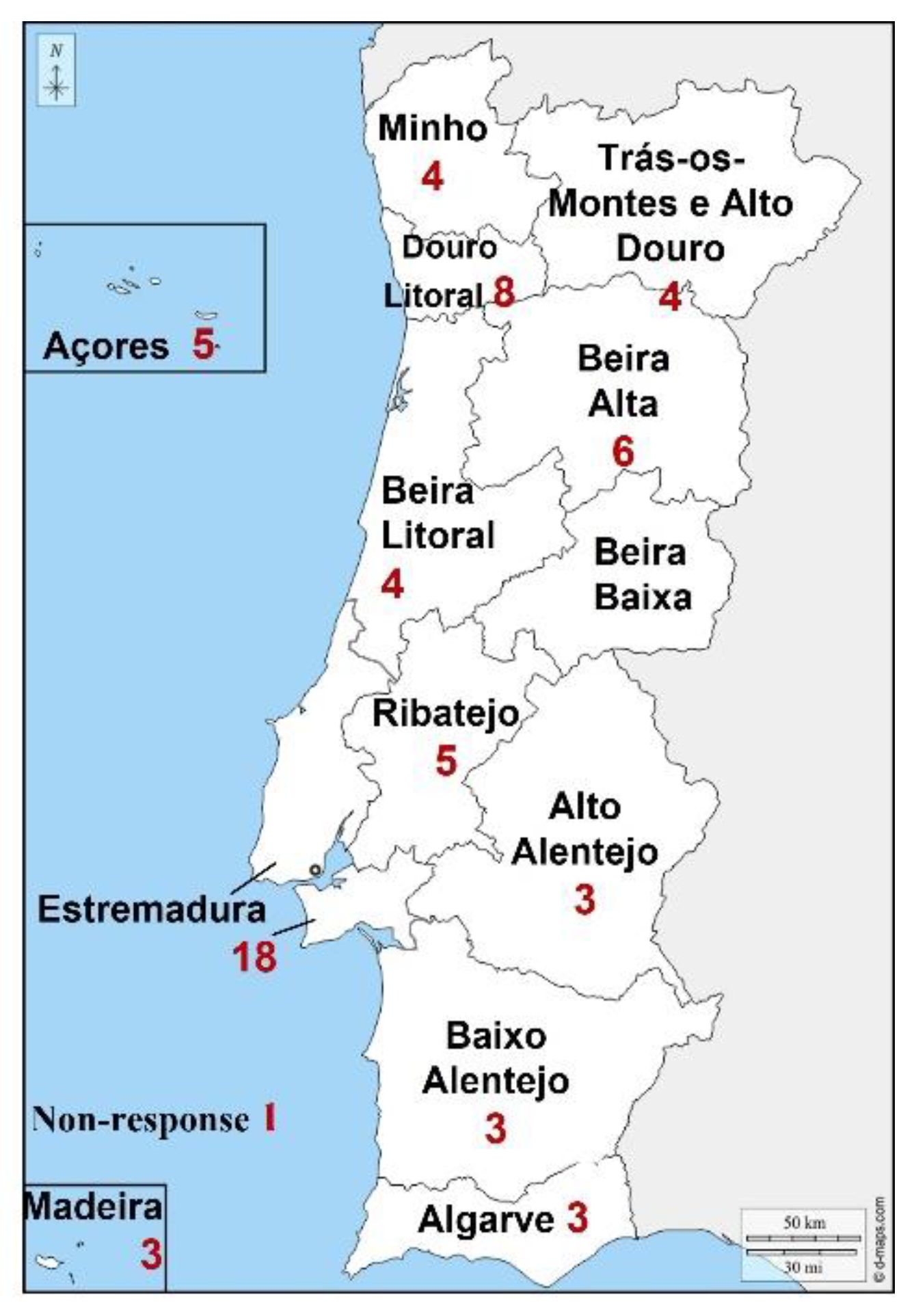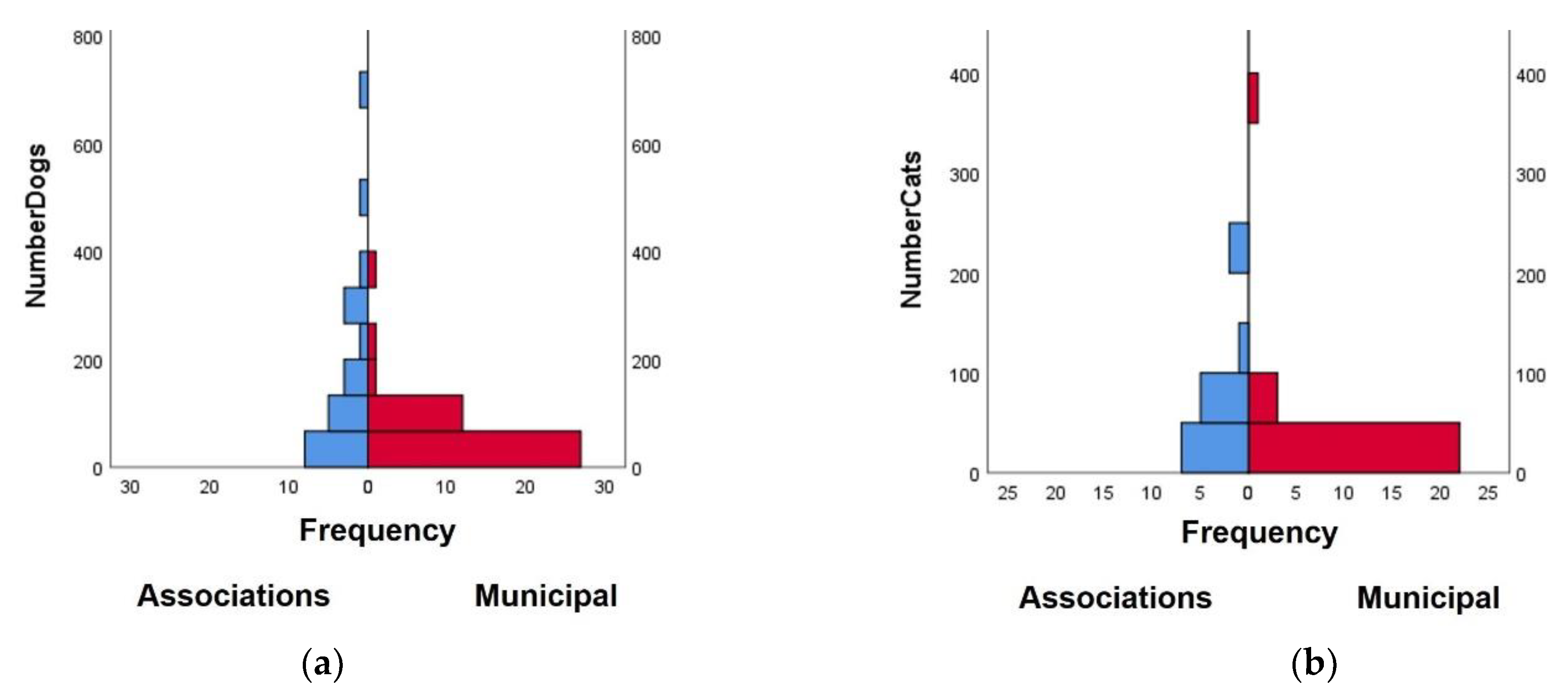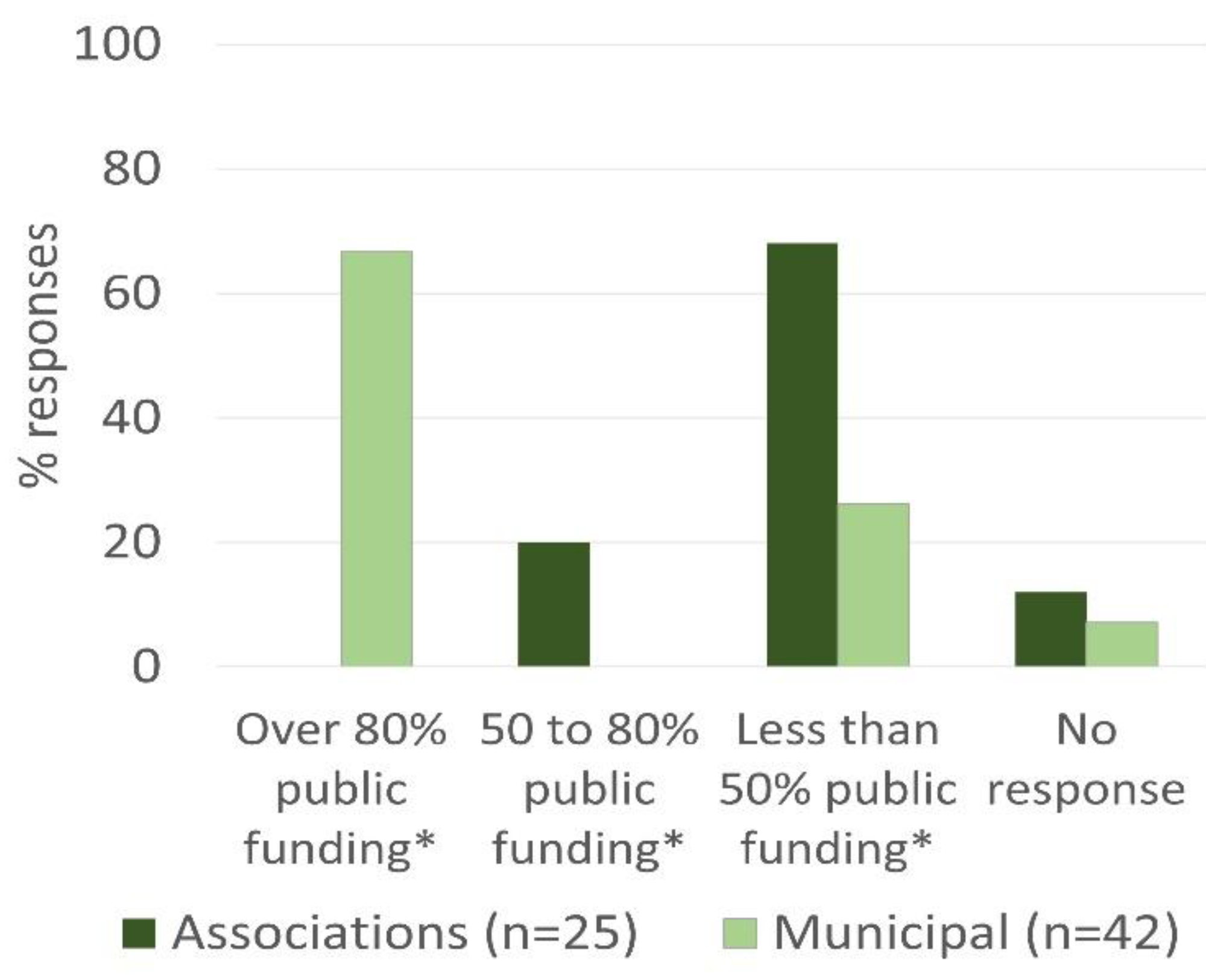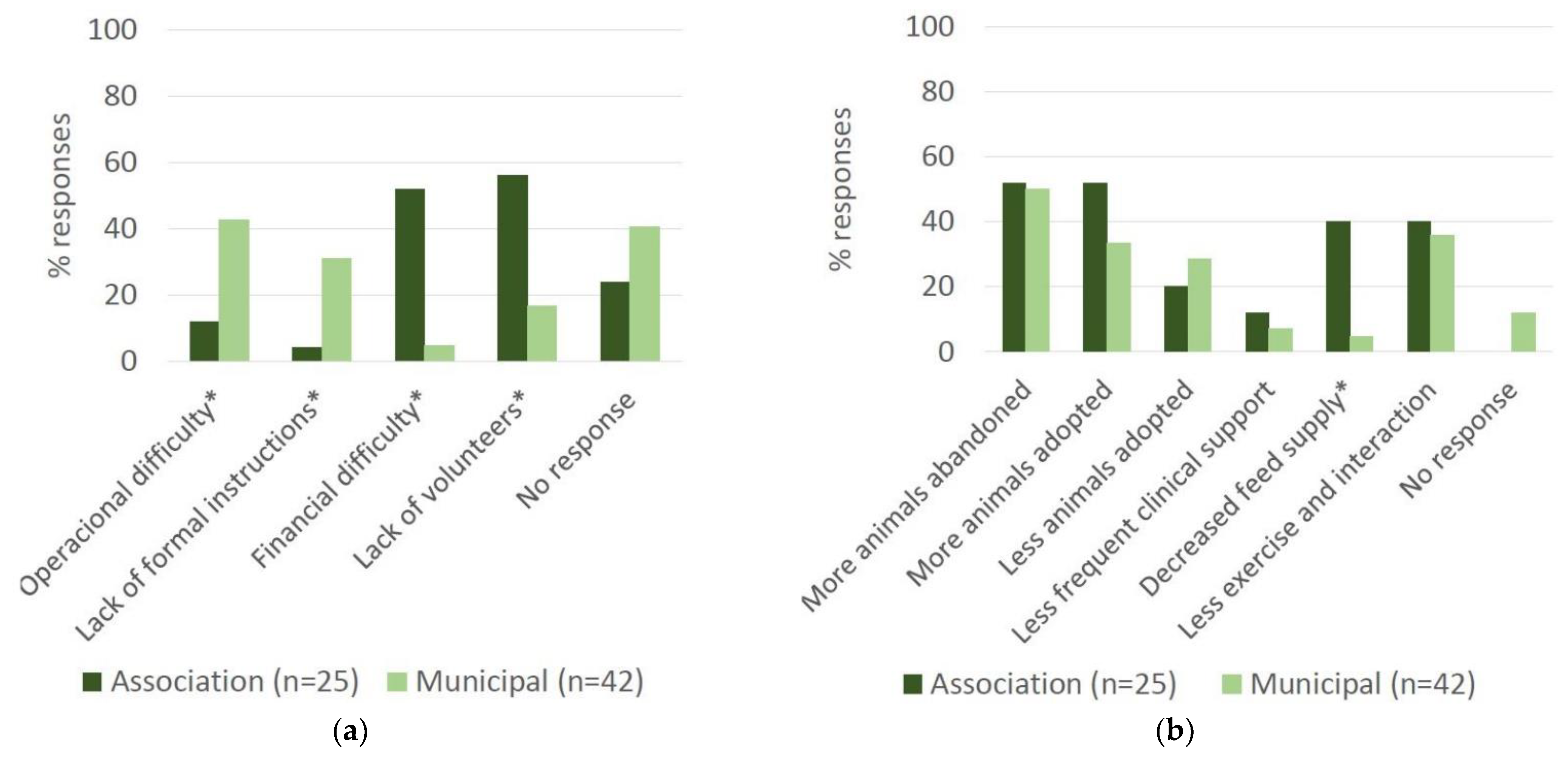Impact of COVID-19 Restrictions in Portugal: A Questionnaire to Municipal and Animal Association Shelters
Abstract
:Simple Summary
Abstract
1. Introduction
2. Materials and Methods
2.1. Questionnaire
2.1.1. Characterization of Animal Shelters
2.1.2. Impact of COVID-19 Restrictions
2.2. Data Analysis
3. Results
3.1. Response Rate and Geographical Distribution
3.2. Characterization of Animal Shelters
3.3. Impact of COVID-19 Restrictions
4. Discussion
5. Conclusions
Supplementary Materials
Author Contributions
Funding
Institutional Review Board Statement
Data Availability Statement
Acknowledgments
Conflicts of Interest
References
- Gortázar, C.; de la Fuente, J. COVID-19 is likely to impact animal health. Prev. Vet. Med. 2020, 180, 105030. [Google Scholar] [CrossRef]
- Paulino, M.; Dumas-Diniz, R.; Brissos, S.; Brites, R.; Alho, L.; Simões, M.R.; Silva, C.F. COVID-19 in Portugal: Exploring the immediate psychological impact on the general population. Psychol. Health Med. 2020, 26, 44–55. [Google Scholar] [CrossRef]
- Baptista, J.; Blache, D.; Cox-Witton, K.; Craddock, N.; Dalziel, T.; de Graaff, N.; Fernandes, J.; Green, R.; Jenkins, H.; Kahn, S.; et al. Impact of the COVID-19 Pandemic on the Welfare of Animals in Australia. Front. Vet. Sci. 2021, 7, 621843. [Google Scholar] [CrossRef]
- Bowen, J.; García, E.; Darder, P.; Argüelles, J.; Fatjó, J. The effects of the Spanish COVID-19 lockdown on people, their pets, and the human-animal bond. J. Vet. Behav. 2020, 40, 75–91. [Google Scholar] [CrossRef] [PubMed]
- De Briyne, N.; Dalla Villa, P.; Ellis, D.; Golab, G.; Gruszynski, K.; Hammond-Seaman, A.; Moody, S.; Noga, Z.; Pawloski, E.; Ramos, M.; et al. Overcoming the Impact of COVID-19 on Animal Welfare: COVID-19 Thematic Platform on Animal Welfare. OIE Bull. 2020. Available online: https://oiebulletin.com/?p=15661 (accessed on 27 July 2021).
- Marchant-Forde, J.N.; Boyle, L.A. COVID-19 Effects on Livestock Production: A One Welfare Issue. Front. Vet. Sci. 2020, 7, 585787. [Google Scholar] [CrossRef] [PubMed]
- Parry, N.M. COVID-19 and pets: When pandemic meets panic. Forensic Sci. Int. Rep. 2020, 2, 100090. [Google Scholar] [CrossRef]
- Shi, J.; Wen, Z.; Zhong, G.; Yang, H.; Wang, C.; Huang, B.; Liu, R.; He, X.; Shuai, L.; Sun, Z.; et al. Susceptibility of ferrets, cats, dogs, and different domestic animals to SARS-coronavirus-2. Science 2020, 368, 1016–1020. [Google Scholar] [CrossRef] [Green Version]
- Huang, Q.; Zhan, X.; Zeng, X.-T. COVID-19 pandemic: Stop panic abandonment of household pets. J. Travel Med. 2020, 27, taaa046. [Google Scholar] [CrossRef] [Green Version]
- Ho, J.; Hussain, S.; Sparagano, O. Did the COVID-19 Pandemic Spark a Public Interest in Pet Adoption? Front. Vet. Sci. 2021, 8, 647308. [Google Scholar] [CrossRef]
- Turner, P.; Berry, J.; Macdonald, S. Animal shelters and animal welfare: Raising the bar. Can. Vet. J. 2012, 53, 893–896. [Google Scholar]
- Pittalis, M. Animals Rights Code: What the Draft Law States. Derecho Anim. Forum Anim. Law Stud. 2019, 10, 161–169. [Google Scholar] [CrossRef]
- Limesurvey GmbH. LimeSurvey: An Open Source Survey Tool; Limesurvey GmbH: Hamburg, Germany, 2019. [Google Scholar]
- Campbell, I. Chi-squared and Fisher–Irwin tests of two-by-two tables with small sample recommendations. Stat. Med. 2007, 26, 3661–3675. [Google Scholar] [CrossRef] [PubMed]
- Richardson, J. The analysis of 2 × 2 contingency tables-Yet again. Stat. Med. 2011, 30, 890. [Google Scholar] [CrossRef]
- MedCalc Software Ltd. Comparison of Proportions Calculator. Version 20009. Available online: https://www.medcalc.org/calc/comparison_of_proportions.php (accessed on 10 July 2021).
- IBM Corp. SPSS Statistics for Windows; IBM: Armonk, NY, USA, 2019. [Google Scholar]
- Bradley, J.; Rajendran, S. Increasing adoption rates at animal shelters: A two-phase approach to predict length of stay and optimal shelter allocation. BMC Vet. Res. 2021, 17, 1–16. [Google Scholar] [CrossRef]
- Battersea. Battersea Research Reveals Imminent Animal Welfare Crisis for Lockdown Pets. Available online: https://www.battersea.org.uk/about-us/press/press-releases/battersea-research-reveals-‘imminent’-animal-welfare-crisis-lockdown (accessed on 27 July 2021).
- Kim, J. Social Finance Funding Model for Animal Shelter Programs: Public–Private Partnerships Using Social Impact Bonds. Soc. Anim. 2018, 26, 259–276. [Google Scholar] [CrossRef]
- Connolly, J. Governing Towards ‘One Health’: Establishing Knowledge Integration in Global Health Security Governance. Glob. Policy 2017, 8, 483–494. [Google Scholar] [CrossRef] [PubMed] [Green Version]
- Pinillos, R.G. One welfare impacts of COVID-19: A summary of key highlights within the one welfare framework. Appl. Anim. Behav. Sci. 2021, 236, 105262. [Google Scholar] [CrossRef] [PubMed]
- Rault, J.-L.; Waiblinger, S.; Boivin, X.; Hemsworth, P. The Power of a Positive Human–Animal Relationship for Animal Welfare. Front. Vet. Sci. 2020, 7, 590867. [Google Scholar] [CrossRef] [PubMed]
- Menor-Campos, D.J.; Molleda-Carbonell, J.M.; López-Rodríguez, R. Effects of exercise and human contact on animal welfare in a dog shelter. Vet. Rec. 2011, 169, 388. [Google Scholar] [CrossRef]
- Fatjó, J.; Bowen, J.; García, E.; Calvo, P.; Rueda, S.; Amblás, S.; Lalanza, J.F. Epidemiology of Dog and Cat Abandonment in Spain (2008–2013). Animals 2015, 5, 426–441. [Google Scholar] [CrossRef]
- Center of Disease Control. Animals and COVID-19. Available online: https://www.cdc.gov/coronavirus/2019-ncov/daily-life-coping/animals.html (accessed on 27 July 2021).
- Morgan, L.; Protopopova, A.; Birkler, R.I.D.; Itin-Shwartz, B.; Sutton, G.A.; Gamliel, A.; Yakobson, B.; Raz, T. Human–dog relationships during the COVID-19 pandemic: Booming dog adoption during social isolation. Humanit. Soc. Sci. Commun. 2020, 7, 155. [Google Scholar] [CrossRef]
- Afrin, S.; Chowdhury, F.J.; Rahman, M. COVID-19 Pandemic: Rethinking Strategies for Resilient Urban Design, Perceptions, and Planning. Front. Sustain. Cities 2021, 3, 668263. [Google Scholar] [CrossRef]
- Hoy-Gerlach, J.; Rauktis, M.; Newhill, C. (Non-human) animal companionship: A crucial support for people during the covid-19 pandemic. Soc. Regist. 2020, 4, 109–120. [Google Scholar] [CrossRef]
- Carr, D.; Friedmann, E.; Gee, N.; Gilchrist, C.; Sachs-Ericsson, N.; Koodaly, L. Dog Walking and the Social Impact of the COVID-19 Pandemic on Loneliness in Older Adults. Animals 2021, 11, 1852. [Google Scholar] [CrossRef] [PubMed]
- SAVSNET. Impact of Covid-19 on Companion Animal Veterinary Practice: Report 6; Small Animal Veterinary Surveillance Network: Wirral, UK, 2020; Volume 3, pp. 1–25. Available online: https://www.liverpool.ac.uk/media/livacuk/savsnet/Impact,of,COVID-19,on,companion,animal,veterinary,practice,report,6.pdf (accessed on 27 July 2021).





Publisher’s Note: MDPI stays neutral with regard to jurisdictional claims in published maps and institutional affiliations. |
© 2021 by the authors. Licensee MDPI, Basel, Switzerland. This article is an open access article distributed under the terms and conditions of the Creative Commons Attribution (CC BY) license (https://creativecommons.org/licenses/by/4.0/).
Share and Cite
Gomes-Neves, E.; Marques, S.; Alves-Pereira, A.; Osório, P.; Müller, A.; Baptista, C.S. Impact of COVID-19 Restrictions in Portugal: A Questionnaire to Municipal and Animal Association Shelters. Animals 2021, 11, 2532. https://doi.org/10.3390/ani11092532
Gomes-Neves E, Marques S, Alves-Pereira A, Osório P, Müller A, Baptista CS. Impact of COVID-19 Restrictions in Portugal: A Questionnaire to Municipal and Animal Association Shelters. Animals. 2021; 11(9):2532. https://doi.org/10.3390/ani11092532
Chicago/Turabian StyleGomes-Neves, Eduarda, Sara Marques, Adélia Alves-Pereira, Pedro Osório, Alexandra Müller, and Cláudia S. Baptista. 2021. "Impact of COVID-19 Restrictions in Portugal: A Questionnaire to Municipal and Animal Association Shelters" Animals 11, no. 9: 2532. https://doi.org/10.3390/ani11092532
APA StyleGomes-Neves, E., Marques, S., Alves-Pereira, A., Osório, P., Müller, A., & Baptista, C. S. (2021). Impact of COVID-19 Restrictions in Portugal: A Questionnaire to Municipal and Animal Association Shelters. Animals, 11(9), 2532. https://doi.org/10.3390/ani11092532







